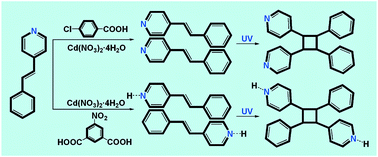a College of Chemistry, Chemical Engineering and Materials Science, Soochow University, Suzhou 215123, PR China
b College of Chemistry and Materials Science, Huaibei Normal University, Huaibei 235000, PR China
c State Key Laboratory of Organometallic Chemistry, Shanghai Institute of Organic Chemistry, Chinese Academy of Sciences, Shanghai 200032, PR China
CrystEngComm 2014, 16, 76-81
Two coordination complexes [Cd2(CBA)4(4-spy)4] (1) and [Cd2(5-NO2-1,3-BDC)2(5-NO2-1,3-HBDC)2(H2O)4]·(4-spy–H)2 (2) were prepared by the hydrothermal reactions of Cd(NO3)2·4H2O, 4-styrylpyridine (4-spy) and 4-chlorobenzoic acid (HCBA) or 5-nitrobenzene-1,3-dicarboxylic acid (5-NO2-1,3-H2BDC). Each pair of 4-spy molecules in [Cd2(CBA)4(4-spy)4] and [Cd2(5-NO2-1,3-BDC)2(5-NO2-1,3-HBDC)2(H2O)4]·(4-spy–H)2 are arranged in a head-to-head (HH) or head-to-tail (HT) fashion, which, upon UV irradiation, dimerizes into 1,2-bis(4-pyridyl)-3,4-bis(phenyl)cyclobutane (HH-ppcb) or 1,3-bis(4-pyridyl)-2,4-bis(phenyl)cyclobutane (HT-ppcb) in 100% yield, respectively. Compared with liquid-phase organic reactions, these solid-state photochemical [2 + 2] cycloadditions of olefin molecules provide good opportunities to synthesize regiospecific cyclobutanes.

链接: //pubs.rsc.org/en/content/articlelanding/2013/ce/c3ce41609g#!divAbstract